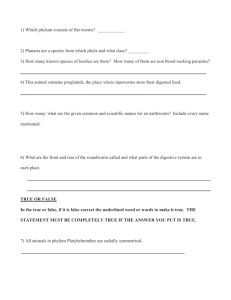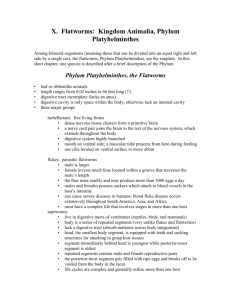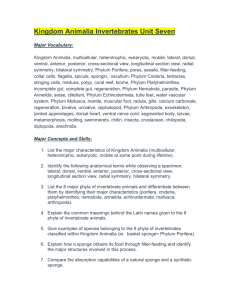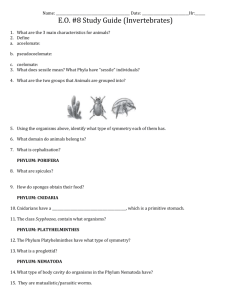Phylum Platyhelminthes
advertisement
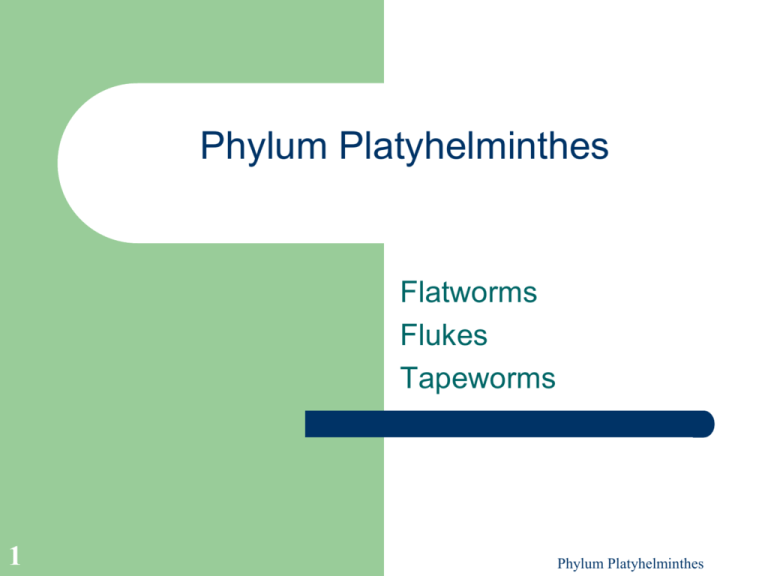
Phylum Platyhelminthes Flatworms Flukes Tapeworms 1 Phylum Platyhelminthes Phylum Platyhelminthes The phylum consists of four classes – – – Turbellaria Trematoda Cestoda Triclad Flatworm 2 Phylum Platyhelminthes Reproduction 3 Almost all are simultaneous hermaphrodites Parasitic species (flukes and tapeworms) have complex lifecycles, with various hosts and several different larval stages Incredible powers of regeneration Phylum Platyhelminthes Nervous System Free-living species usually have a well-developed sensory system Parasites generally have less elaborate systems. WHY? 4 Phylum Platyhelminthes Taxonomic Summary Phylum Platyhelminthes (Flatworms) – – – – 5 Class Turbellaria Class Cestoda Class Trematoda Class Monogeneans Phylum Platyhelminthes Class Turbellaria Most are free–living, tiny and inconspicuous – Primarily marine and freshwater Free-living Flatworm 6 Phylum Platyhelminthes Flatworm Body Plans 7 Exhibit bilateral symmetry, acoelomate, and are triploblastic Parenchyma tissue Phylum Platyhelminthes Digestion and Excretion 8 Mouth is usually located at the anterior end or mid-body on ventral surface Excretory system – Contains flame bulbs Phylum Platyhelminthes Regeneration 9 Many species posses remarkable powers of regeneration and repair wounds Phylum Platyhelminthes Turbellarian Lifestyles 10 Most are benthic Posses several nerve cords with a centralized ganglia (brain) Phylum Platyhelminthes Turbellarian Habits 11 Some species also have a protrusible pharynx that captures food and transfers it into the mouth – Can be carnivores or scavenge on dead animals and detritus Phylum Platyhelminthes Reproduction Reproduction occurs with the reciprocal exchange of sperm Fertilized eggs are released and usually develop directly into flatworms – 12 Muller's larva Phylum Platyhelminthes Class Cestoda (Tapeworms) Defining characteristics – – 13 Scolex Proglottids Phylum Platyhelminthes Proglottids 14 Proglottids – Each animal can be 3,000 – 4,000 per animal – Amazing reproductive output – Each may contain several ovaries and 1,000 distinct testes Phylum Platyhelminthes Beef tapeworm 15 Phylum Platyhelminthes Problems of a parasitic existence 16 Reproduce within the definitive host Get fertilized eggs out of the host Contact a new and appropriate host Obtain entrance into the host Locate the appropriate environment within the host Maintain position within the host Withstand an often anaerobic environment Avoid digestion or attack by the hosts immune system Avoid killing the host, at least until reproduction is completed Phylum Platyhelminthes Class Trematoda (Flukes) 17 All are external and internal parasites of other animals Leech-like bodies with a sucker at each end Have a gut and welldeveloped reproductive system, never segmented Phylum Platyhelminthes Trematoda Lifecycles 18 The lifecycle is complex with up to 4 different hosts and several larval types Phylum Platyhelminthes Trematodes of Concern Schistosomiasis – – – 19 Deadly prominent disease in many regions of the world Bores into the skin of the definitive host and travels in the circulatory system to the heart the lungs and the kidneys where it feeds and grows Inflammation is caused by eggs becoming trapped in the hosts tissues Chinese liver fluke – – – Lives in the bile duct of humans, cats, and dogs (1-2 cm.) Goes through two intermediate hosts Infection occurs from ingestion of raw fish Phylum Platyhelminthes

